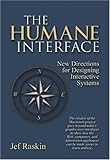[0] https://en.wikipedia.org/wiki/The_Humane_Interface [1] https://www.amazon.co.uk/Humane-Interface-Directions-Designi... [2] https://www.mac-history.net/apple-history-2/mac-history/2012...
https://www.amazon.com/Humane-Interface-Directions-Designing...
His book, The Humane Inerface (http://www.amazon.com/The-Humane-Interface-Directions-Intera...) does have some interesting thoughts on how novice and expert users have completely different ways of interacting with machines.
Additionally, the fact that the writer of this post mentions Oberon's zooming user interface and the Canon Cat means I have to encourage anyone interested in this topic to read this wonderful book: http://www.amazon.com/The-Humane-Interface-Directions-Intera...
---
The article linked to at the very beginning is not available on the original site. Here is an archive.org link: http://web.archive.org/web/20090416033922/http://stevenf.tum...
http://www.amazon.com/The-Humane-Interface-Directions-Intera...
http://www.amazon.com/The-Humane-Interface-Directions-Intera...
While technologically they are decades out of date, from a UX perspective, there is a lot to be learned from using one.
Some of the concepts, such as a document-oriented system that never requires the user to launch or quit an application, nor to "save" their work, would still represent a leap forward today.
I'd love to see a modern OS built with the concepts of a humane interface today. Even the iOS and Android systems carry legacies of the WIMP interface instead of Raskin's humane approach.
I've spoken at the BIL Conference about the idea of bringing Jef Raskin's (and others) ideas into the modern age: http://www.bilconference.com/videos/rethinking-modern-gui-ja...
This is a great historical repository, but worth reading for the ways some of the concepts can be used today.
And of course, anyone who's interested in what made the Cat special should read Jef Raskin's book: http://www.amazon.com/Humane-Interface-Directions-Designing-...
http://www.amazon.com/Humane-Interface-Directions-Designing-...
The Design of Everyday Things (http://www.amazon.com/Design-Everyday-Things-Donald-Norman/d...)
The Humane Interface (http://www.amazon.com/Humane-Interface-Directions-Designing-...)
Contextual Design (http://www.amazon.com/Contextual-Design-Customer-Centered-In...)
http://en.wikipedia.org/wiki/Archy http://en.wikipedia.org/wiki/Zooming_user_interface http://www.amazon.com/Humane-Interface-Directions-Designing-...


Appears very much in the spirit of Jef Raskin's The Humane Interface [2000]
https://en.wikipedia.org/wiki/The_Humane_Interface
https://www.amazon.com/Humane-Interface-Directions-Designing...
https://en.wikipedia.org/wiki/Jef_Raskin
As u/chrisweekly alludes to elsethread, Obsidian is a bit like WonderOS.
Could WonderOS be implemented as a "Obsidian as an operating system shell"? That'd be a "leaky abstraction", of course. But there are many precedents.
Sorry, my pre-senile brain isn't quickly recalling the variety of experiments made to run on top of early Windows. Just a list of possibles:
- Norton Commander was ported to Windows, right?
- Assymetrix (Paul Allen's startup focused on actor based programming) did something
- Wasn't there a desktop based on GEM?
Aha. Here's a few more contenders:
List of alternative shells for Windows https://en.wikipedia.org/wiki/List_of_alternative_shells_for...
--
Anyway... WonderOS is terrific. So much work. It's definitely worthy of implementing a prototype.
Please share any future updates. Thanks.